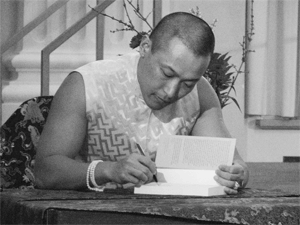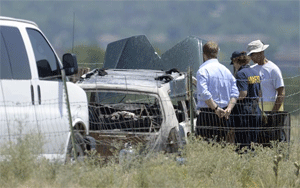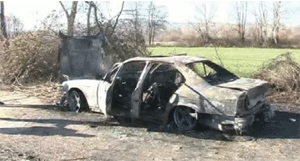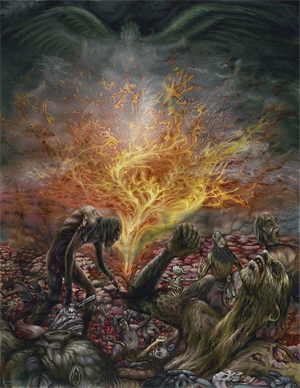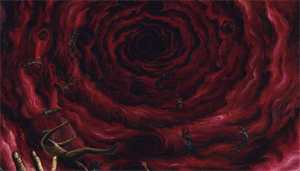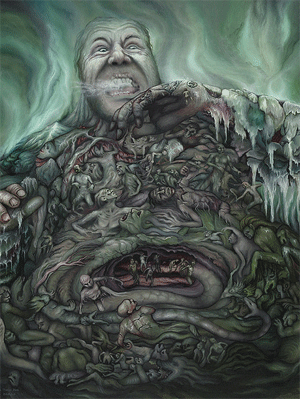Suicide by Self-Burning While Driving a Vehicleby Motoki Osawa [1] *, Yoo Tanaka [1] [2], Yu Kakimoto [1], and Fumiko Satoh [1]
1 Department of Forensic Medicine, Tokai University School of Medicine, Japan
2 3rd Regional Coast Guard Headquarters, Japan
Submitted: 01 November 2016
Accepted: 17 November 2016
Published: 18 November 2016
© 2016 Osawa et al.
NOTICE: THIS WORK MAY BE PROTECTED BY COPYRIGHTYOU ARE REQUIRED TO READ
THE COPYRIGHT NOTICE AT THIS LINK BEFORE YOU READ THE FOLLOWING WORK, THAT IS AVAILABLE SOLELY FOR PRIVATE STUDY, SCHOLARSHIP OR RESEARCH PURSUANT TO 17 U.S.C. SECTION 107 AND 108. IN THE EVENT THAT THE LIBRARY DETERMINES THAT UNLAWFUL COPYING OF THIS WORK HAS OCCURRED, THE LIBRARY HAS THE RIGHT TO BLOCK THE I.P. ADDRESS AT WHICH THE UNLAWFUL COPYING APPEARED TO HAVE OCCURRED. THANK YOU FOR RESPECTING THE RIGHTS OF COPYRIGHT OWNERS.
AbstractThree cases of suicide by self-burning while driving a vehicle are introduced, in which planned multiple suicide, for which more than two methods are combined, was suspected. They committed suicide by igniting flammable matter while driving and the vehicle collided with a guard rail or walls at high speed. It might be carried out to camouflage a suicidal action as an ordinary accident for insurance fraud or other purposes. No alcohol or drugs were detected, and carbon monoxide hemoglobin saturation was high: 52% on average. Unlike typical social self-immolation, middle aged males who had no history of mental disorder committed this type of aggressive self-inflicted burn.
ABBREVIATIONSCOHb: Carbon Monoxide Hemoglobin
INTRODUCTIONA vehicle fire occurred in a tunnel of an expressway one evening in 2015. The driver, a woman in her 30s, was rescued. The driver later confessed that she had attempted suicide by sprinkling kerosene on the passenger seat of the vehicle and setting it ablaze with a cigarette lighter. A survey of the Japanese literature reveals that Yamauchi et al., reported a similar case of suicide by vehicle fire, in which a vehicle in a tunnel of an expressway collided with a wall, causing a vehicle fire, after which a middle-aged man was found dead [1]. Because a melted plastic tank was found in the passenger seat, it was inferred that the driver had ignited the accelerant by himself, with the intent of suicide. It might be said that this case is one type of planned multiple suicide for which more than two methods are combined [2]. The youth tends toward aggressive behaviors accompanied by high seriousness and lethality [3,4].
As suicide means, induction of exhaust gas in a stationary vehicle has been popular [5,6], but attempt on moving wheel such as crash is rare. According to the general statement related to suicide during vehicle driving summarized by Pompili et al., based on reports from various nations and regions [7], driver suicides account for 1%-7% of all driver deaths. They concluded that, generally speaking, more than 2% of all deaths can be judged as suicide. Suicidal actions taken during driving usually show a pattern in which a vehicle with one driver causes an accident independently, although other vehicles are involved in some cases [8]. As for the specific suicidal means of automobile driving, intentional collision accidents are common, although various accidents such as plummeting into a valley also occur [9]. Shkrum et al., reviewed self-burning suicides in Canada between 1986 and 1988. Six of 43 victims reportedly found inside the compartment of automobiles, and kerosene was used as an accelerant in one case [10]. Viklund et al., retrospectively analyzed 118 cases of death caused by vehicle fire in Sweden, reporting that 5 cases (3%) were judged to be suicide [11]. However, details of the circumstances in both case reports remain unknown.
In the current investigation, accidents suggestive of intentional vehicle fire death with the intent of suicide were extracted from past autopsy cases and analyzed.
CASE PRESENTATIONCases subjected to autopsy in 16 years of 1999-2014 at the Department of Forensic Medicine, Tokai University School of Medicine were reviewed. Self-burning suicide cases occurred 63 times during the period. Of those, 3 cases are suspected of suicide by vehicle fire. An outline of each case is presented below.
Case #1In the evening, a station wagon collided with the right guard rail of the automobile expressway, caught fire and burst into flames in a tunnel about 200 m further down the road. After the fire was extinguished, the driver, a man in his 40s, was found dead in the driver’s seat. A plastic tank was found under the rear seat, kerosene reaction was detected in the vehicle, and parts of a cigarette lighter were found. Although no suicide note was found, he was reportedly troubled by the fact that an adulterous relationship had been discovered. He had no history of mental disorder such as depression. Autopsy and examination results revealed excessive carbonization of the entire body and soot aspiration image. Blood alcohol tests, urinary alcohol tests, and drug and toxicology tests were negative, although carbon monoxide hemoglobin (COHb) saturation was 48%.
Case #2In the early morning, on a highway, a passenger car collided with a concrete wall divider from the frontage road, caught fire and burst into flames (Figure 1). After the fire was extinguished, a man in his 60s was found dead in the driver’s seat. In all, four metal paint cans were found in the passenger seat and rear seat. Parts of a cigarette lighter were also found. Results showed that he had large debts and had taken out more than one life insurance policy on himself. His body was carbonized, and had been incinerated to the torso. Confirmation of the soot aspiration image was difficult. Blood alcohol, drug, and toxicology tests yielded negative results. COHb saturation was 31%. No organic matter was detected in the blood using GC/MS method.
Case #3A passenger car collided with the guard rail and burst into flames in the early morning at a downhill curve in a mountain area. After the fire was extinguished, a man in his 50s was found dead in the driver’s seat. A lump of melted plastic in the shape of plastic tank was found and kerosene reaction was detected in the compartment. He had no history of mental disorder such as depression and exhibited no speech or behavior suggestive of suicide. Autopsy and examination findings revealed that his entire body was burned excessively and soot aspiration image was noticed. Blood and urinary alcohol test, and toxicology were negative, and COHb saturation was 77%.
RESULTS AND DISCUSSIONItems common to the three cases described above are presented in Table (1). Flammable matter was ignited while driving at high speed on the express way or downhill and the vehicle collided with a guard rail or walls. The vehicle then burst into flames. The victim was found dead in the driver’s seat. No alcohol or drugs were detected. COHb saturation was high: 52% on average. Bohnert described that in deaths occurring after car fires due to collisions, the COHb value are usually <40%, often even <20% [12]. This report suggests that the victims did not attempt to escape even after the outbreak of fire and remained in the vehicle. Lam et al., found a statistically significant association between suicidal thoughts and injuries by automobile collision [13].
Table 1: Characteristics of three cases of suicide by self-inflicted burn while driving a vehicle.
Age, sex / Middle-aged men
Situations / Single driver, collision with side wall or guardrail
Burns / Severe
Accelerant / Kerosene (2), Paint products (1)
COHb content / 52% (mean)
Blood alcohol / Not detected
Other drugs / Not detected
Suicide note / None
Psychiatric history / None
In the three cases, plastic tanks for kerosene or metallic paint cans were left in the passenger compartment. In two cases, a kerosene reaction was detected in the vehicle. From these findings, all cases are deemed as intentional fire outbreak and are regarded as complicated and elaborate methods of suicide. The three presented victims clearly prepared to complete suicide. In contrast to younger age of suicide that exhibits the predisposition of impulsive and aggressive behaviors [3,4], these middle aged males, with the mean age of 56 years old, characteristically selected the planed methods accompanied by high seriousness and lethality.
Traffic accidents involving two-wheel vehicles and automobiles normally occur because of carelessness. In reality, one normally considers that fatal traffic accidents are not intentional but accidental. If someone intends to camouflage a suicidal action as an ordinary accident for insurance fraud or other purposes, a traffic accident might well become one option. It has been pointed out that fatal automobile accident data apparently fail to exclude possible suicide or suspected suicide [14]. In these three cases, fire outbreak did not occur in a stationary vehicle, although the vehicle came to a standstill after collision. Evidence indicates that the drivers attempted to camouflage their intentions as an ordinary traffic accident. Moreover, they attempted to provide beneficiaries with a favorable payment of life insurance [15]. Regarding other possibilities, they probably wanted their families not to suffer from the disgrace of suicide by pretending a traffic accident.
No victim had a history of mental disorder such as depression. Franchitto et al., reported that 42% of the patients who attempted self-burning suffered from depression. Most of them had a history of attempted suicide by some other method [16]. It is characteristic that no victim in any of the three cases exhibited a history of mental disorder. Rather, some victims had economic trouble or relationship difficulties.
As for the fire accelerant, kerosene was used in two cases; paint thinner was used in one case. If these flammable materials had not been used, the collision would probably not have produced a vehicle fire. Malic et al., reported that, in 78% of cases of suicide by self-burning, an accelerant such as kerosene was used [17]. They also reported that, in the case of self-burning, with damage intended by the victims themselves, the degree of burn injury was more severe than in cases of assault.
The frequency of self-inflicted burns as a means of suicide apparently depends on the region and sex. Self-burning suicide is generally less common in economically developed countries including Japan: self-burning suicide is used rarely, in about 1% of all suicide cases (1.3% for males; 1.9% for females) [18]. However, it is said that self-burning suicide is markedly influenced by social, cultural, and psychological factors. For example, in Tibet and South Korea, self-burning suicide reportedly accounts for about 5% of all suicide cases [19,20]. Such self-immolation as a cultural or moral statement in India is well-known [21], although no self-immolation occurs for those reasons in Japan. Although self-burning while driving a vehicle as reported this time is truly a rare occurrence, it is considered that economic aspects related to payment of insurance claim or considerations for the victim’s family are important. Similar cases are found only rarely in other countries. It remains unknown whether this phenomenon is peculiar to Japan, or not.
Hernetkoski et al., analyzed accidents in Finland and reported that fatal traffic accidents are decreasing as are deaths of automobile drivers at present, but rates of intentional accidents are increasing [22]. As for distinctive features of such cases, it is said that single-vehicle accidents of vehicles with one person aboard are increasing. Fatal traffic accidents involving vehicle fires probably include some cases of suicide where volatile accelerants are sprayed in the vehicle and ignited by the driver.
CONCLUSIONWe demonstrate a social and clinical topic concerning an aggressive suicide method by self-burning while driving a vehicle. Three victims similarly committed suicide by igniting flammable matter while driving, then the vehicles collided at road side.
It seemed to be carried out to camouflage a suicidal action as an ordinary accident. These middle aged males who had no history of mental disorder committed this type of aggressive self-inflicted burn.
_______________
REFERENCES1. Yamanouchi H, Dewa K, Fukuda M, Motomiya Y, Xu HD, Naito E. Potential suicide of burning vehicle in traffic accident. Jpn J Legal Med. 2006; 60: 168.
2. Racette S, Sauvageau A. Planned and unplanned complex suicides: a 5-year retrospective study. J Forensic Sci. 2007; 52: 449-452.
3. McGirr A, Renaud J, Bureau A, Seguin M, Lesage A, Turecki G. Impulsive-aggressive behaviours and completed suicide across the life cycle: a predisposition for younger age of suicide. Psychol Med. 2008; 38: 407-417.
4. Mento C, Presti EL, Mucciardi M, Sinardi A, Liotta M, Settineri S. Serious Suicide Attempts: Evidence on Variables for Manage and Prevent this Phenomenon. Community Ment Health J. 2016; 52: 582-588.
5. Sarchiapone M, Mandelli L, Iosue M, Andrisano C, Roy A. Controlling access to suicide means. Int J Environ Res Public Health. 2011; 8: 4550-4562.
6. Liotta M, Mento C, Settineri S. Seriousness and lethality of attempted suicide: a systematic review. Aggress Violent Behav. 2015; 21: 97-109.
7. Henderson AF, Joseph AP. Motor vehicle accident or driver suicide? Identifying cases of failed driver suicide in the trauma setting. Injury. 2012; 43: 18-21.
8. Pompili M, Serafini G, Innamorati M, Montebovi F, Palermo M, Campi S, et al. Car accidents as a method of suicide: a comprehensive overview. Forensic Sci Int. 2012; 223: 1-9.
9. Milner A, De Leo D. Suicide by motor vehicle “accident” in Queensland. Traffic Inj Prev. 2012; 13: 342-347.
10.Shkrum MJ, Johnston KA. Fire and suicide: a three-year study of selfimmolation deaths. J Forensic Sci. 1992; 37: 208-221.
11.Viklund Å, Björnstig J, Larsson M, Björnstig U. Car crash fatalities associated with fire in Sweden. Traffic Inj Prev. 2013; 14: 823-827.
12.Bohnert M. Kraftfahrzeugbrand. Rechtsmedizin. 2007; 17: 175-186.
13.Lam LT, Norton R, Connor J, Ameratunga S. Suicidal ideation, antidepressive medication and car crash injury. Accid Anal Prev. 2005; 37: 335-339.
14.Jenkins J, Sainsbury P. Single-car road deaths--disguised suicides? Br Med J. 1980; 281: 1041.
15.Ohberg A, Penttila A, Lonnqvist J. Driver suicides. Br J Psychiatry. 1997; 171: 468-472.
16.Franchitto N, Faurie C, Franchitto L, Minville V, Telmon N, Rougé D. Self-inflicted burns: the value of collaboration between medicine and law. J Forensic Sci. 2011; 56: 638-642.
17.Malic CC, Karoo RO, Austin O, Phipps A. Burns inflicted by self- or by others -- an 11 year snapshot. Burns. 2007; 33: 92-97.
18.White paper on suicide in Japan, 2012.
19.Gauthier S, Reisch T, Bartsch Ch. Self-burning - a rare suicide method in Switzerland and other industrialised nations - a review. Burns. 2014; 40: 1720-1726.
20.Caine PL, Tan A, Barnes D, Dziewulski P. Self-inflicted Burns: 10 year review and comparison to national guidelines. Burns. 2016; 42: 215- 221.
21.Poeschla B, Combs H, Livingstone S, Romm S, Klein MB. Self-immolation: socioeconomic, cultural and psychiatric patterns. Burns. 2011; 37: 1049-1057.
22.Hernetkoski KM, Keskinen EO, Parkkari IK. Driver suicides in Finland-- are they different in northern and southern Finland? Int J Circumpolar Health. 2009; 68: 249-260.

